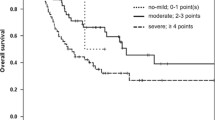Summary
A method is presented for the quantitative analysis of delayed cytokinetic effects resulting from the treatment of L1210 cells with 6-thioguanine (TG). By using dual-parameter (DNA/protein) flow cytometry, we could observe the accumulation of late S/G2/M cells with abnormally high green fluorescence (i.e., protein content), indicative of unbalanced growth. The use of mitotic cells from a pseudotetraploid line (HT29) as external markers for both red and green fluorescence facilitated highly reproducible measurement of the mean green fluorescence (GFLmean) of the arrested late S/G2/M population. We found that the dose dependence of the observed GFLmean values followed the same unusual biphasic pattern as did cytotoxicity in this cell line, indicating that this parameter might be a suitable means of predicting TG-induced toxicity in vivo. We propose that the low background expected for this kind of measurement would make it particularly appropriate for the analysis of clinical specimens (e.g., mononuclear bone marrow cells) from leukemic patients receiving thiopurines, to monitor (and, hopefully, predict) their response to treatment.
Similar content being viewed by others
References
Barranco SC, Humphrey RM (1971) The effects of beta-2′-deoxythioguanosine on survival and progression in mammalian cells. Cancer Res 31: 583
Horakova K, Navarova J, Paterson ARP (1974) The delayed cytotoxic effect of 6-mercaptopurine. Characterization of the unbalanced growth in HeLa cells produced by 6-mercaptopurine. Biochim Biophys Acta 366: 333
Matsumura S, Hoshino T, Weizsaecker M, Deen DF (1983) Paradoxical behavior of 6-mercaptopurine as a cytotoxic agent: decreasing cell kill with increasing drug dose. Cancer Treat Rep 67: 475
Maybaum J, Mandel HG (1981) Differential chromatid damage induced by 6-thioguanine in CHO cells. Exp Cell Res 135: 465
Maybaum J, Mandel HG (1983) Unilateral chromatid damage: a new basis for 6-thioguanine cytotoxicity. Cancer Res 43: 3852
Maybaum J, Hink LA, Roethel WM, Mandel HG (1985) Dissimilar actions of 6-mercaptopurine and 6-thioguanine in Chinese hamster ovary cells. Biochem Pharmacol 34: 3677
Maybaum J, Morgans CW, Hink LA (1987) Comparison of in vivo and in vitro effects of continuous exposure of L1210 cells to 6-thioguanine. Cancer Res 47: 3083
Pollack A, Moulis H, Block NL, Irvin GL III (1984) Quantitatric of cell kinetic responses using simultaneous flow cytometric measurements of DNA and nuclear protein. Cytometry 5: 473
Wotring LL, Roti Roti JL (1980) Thioguanine-induced S and G2 blocks and their significance to the mechanism of cytotoxicity. Cancer Res 40: 1458
Author information
Authors and Affiliations
Additional information
Recipient of a Faculty Development Award from the Pharmaceutical Manufacturers Association Foundation.
Rights and permissions
About this article
Cite this article
Maybaum, J., Ting, P. & Rogers, C.E. Prediction of thioguanine-induced cytotoxicity by dual-parameter flow cytometric analysis. Cancer Chemother. Pharmacol. 24, 291–294 (1989). https://doi.org/10.1007/BF00304760
Received:
Accepted:
Issue Date:
DOI: https://doi.org/10.1007/BF00304760




